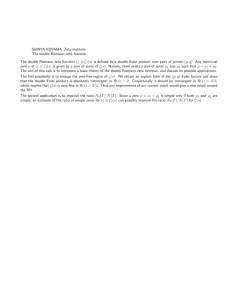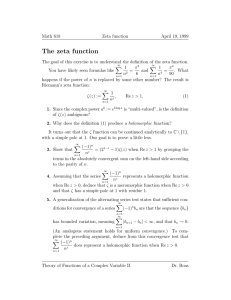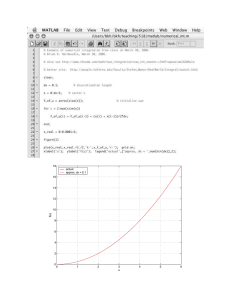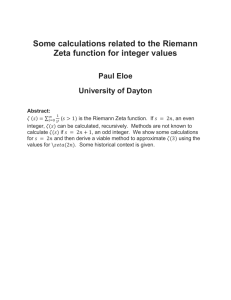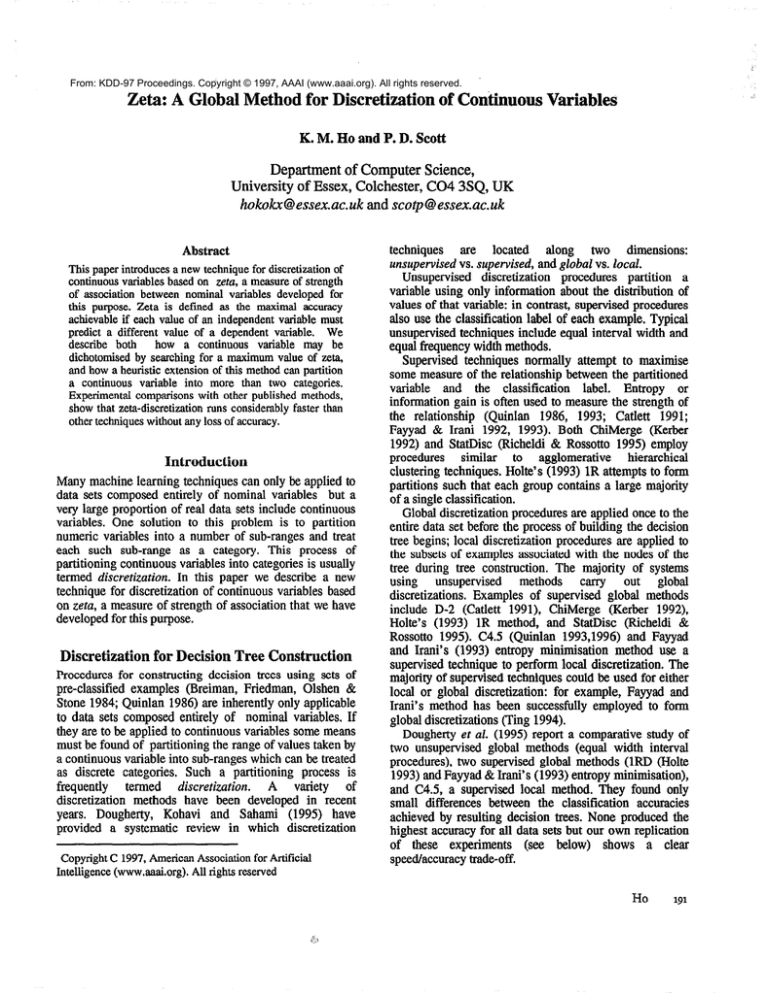
From: KDD-97 Proceedings. Copyright © 1997, AAAI (www.aaai.org). All rights reserved.
Zeta: A Global Method for Discretization of Cotitinuous Variables
K. M. Ho and P. D. Scott
Department of Computer Science,
University of Essex,Colchester,CO4 3SQ, UK
hokokx@essex.ac.uk and scolp@essex.ac.uk
Abstract
This paper introduces a new technique for discretization of
continuous variables based on zeru, a measure of strength
of association between nominal variablesdeveloped
for
this purpose. Zeta is defined as the maximal accuracy
achievable if each value of an independent variable must
predict a different value of a dependent variable. We
describe both
how a continuous variable may be
dichotomised by searching for a maximum value of zeta,
and how a heuristic extension of tbis method can partition
a continuous variable into more than two categories.
Experimental comparisons with other published methods,
show that zeta-discretization runs considerably faster than
other techniqueswithout any loss of accuracy.
Introduction
Many machinelearning techniquescan only be appliedto
data sets composedentireiy of nominal variabies but a
very large proportion of real data setsinclude continuous
variables. One solution to this problem is to partition
numeric variablesinto a number of sub-rangesand treat
each such sub-range as a category. This process of
partitioning continuousvariablesinto categories is usually
termed discrerization.In this paper we describea new
techniquefor discretizationof continuousvariablesbased
on zeta, a measureof strengthof associationthat we have
developedfor this purpose.
Discretization for Decision Tree Construction
Proceduresfor constructingdecision trees using sets of
pre-classifiedexamples(Breiman, Friedman, Olshen &
StQne 15)84!
5lTP.j&rcflfly
., fhiinlnn
~ --___--- 19Rhi
-c --, --
Qnjy Qp]i&ie
to data sets composedentirely of nominal variables.If
they are to be appliedto continuousvariablessomemeans
mustbe found of partitioningthe rangeof valuestakenby
a continuousvariableinto sub-rangeswhich can be treated
as discrete categories.Such a partitioning process is
frequently termed discretizatiun. A variety of
discretization methods have been developedin recent
years. Dougherty, Kohavi and Sahami (1995) have
provided a systematicreview in which discretization
Copyright C 1997, American Association for Artificial
Intelligence (www.aaai.org). All rights reserved
techniques are located along two dimensions:
unsupervised vs. supervised, and global vs. local.
Unsuperviseddiscretization procedures partition a
variable using only information about the distribution of
valuesof that variable:in contrast,supervisedprocedures
also use the classificationlabel of each example.Typical
unsupervisedtechniquesinclude equal interval width and
equalfrequencywidth methods.
Supervisedtechniquesnormally attempt to rnaximise
somemeasureof the relationshipbetweenthe partitioned
variable and the classification label. Entropy or
information gain is often usedto measurethe strengthof
the relationship (Quinlan 1986, 1993; Catlett 1991;
Fayyad & Irani 1992, 1993). Both ChiMerge (Kerber
1992) and StatDisc (Richeldi & Rossotto1995) employ
procedures similar to agglomerative hierarchical
clusteringtechniques.Holte’s (1993) 1R attemptsto form
partitions such that each group containsa large majority
of a singleclassification.
Global discretizationproceduresare appliedonceto the
entire data set beforethe processof building the decision
tree begins;local discretizationproceduresare appliedto
the subsetsof examplesassociatedwith the nodesof the
tree during tree construction.The majority of systems
1nrino
olnhd
UL.“q.wS
1LVYV nmthnrlc
lll”Ul”Y” cqr
out
UUlllb IlnallnPnricl=rl
pvv&u
discretizations.Examples of supervisedglobal methods
include D-2 (Catlett 1991), ChiMerge (Kerber 1992),
Holte’s (1993) 1R method, and StatDisc (Richeldi &
Rossotto1995). C4.5 (Quinlan 1993,1996)and Fayyad
and Irani’s (1993) entropy minimisation method use a
supervisedtechniqueto perform local discretization.The
majority of supervisedtechniquescould be usedfor either
local or global discretization:for example, Fayyad and
Tm..:~”
mad.&4
l...”
haa..
n..,.nann&ll.,
~.n..l,w.Lwl
.A CAllillll
a III~UI”U
lldJ
“GGll
JubLGJJIuILJ
GUqJ’“yal
C” l”llU
global discretizations(Ting 1994).
Doughertyet al. (1995) report a comparativestudy of
two unsupervisedglobal methods (equal width interval
procedures),two supervisedglobal methods(1RD (Holte
1993)andFayyad& Irani’s (1993) entropyminimisation),
and C4.5, a supervisedlocal method. They found only
small differencesbetween the classification accuracies
achievedby resulting decisiontrees. None producedthe
highestaccuracyfor all data setsbut our own replication
of these experiments (see below) shows a clear
speed/accuracy
trade-off.
Ho
191
c4.5
Data Set
allbp
ann-thyroid
..
Average
Continuous
97.45+-0.10
99.61 -I--0.11
Entropy
97.22+-0.16
99.38+-0.13
-m-m .^^
11
I
l54.04
W./Y
IRD
96.05+-0.32
97.64+-0.04
^_^^
>^-
I
t5l.lti
Bin-log I
96.39+-0.32
94.06+-0.19
^>^^ ^A-
n-Bins
96.32vO.13
92.72wO.24
^*^^
^--
Zeta
96.63+-0.23
98.38+-0.16
^^^^
_^^
I
I
I
W.UU
fY.44
UY.YU
I
Table 1: Classification accuracies and standard deviations using C4.5 (Quinlan 1996) with different discretization methods.
Continuous: C4.5 on undiscretized data. Entropy: Global variant of Fayyad & Irani’s (1993) method. 1RD: Holte’s (1993) IR
discretizer. Bin-log 1 and n-Bins: Equal width binning. Zeta: Method proposed in this paper. (c.f. Dougherty et al. 1995)
Zeta: A New Measure of Association
Our initial attempts to develop a fast and accurate
discretization technique basedupon lambda, a widely used
measure of strength of association between nominal
variables (Healey 1990) that measures the proportionate
reduction in prediction error that would be obtained by
using one variable to predict the other, using a modal
value prediction strategy in all cases. Unfortunately
lambda is an ineffective measure in those situations were
the dependencybetween two variables is not large enough
to produce different modal predictions since in such cases
its value is zero.
A closely related measure, which we term zeta, has
beendevelopedthat overcomesthis limitation becauseit is
not based on a modal value prediction strategy: the
assumptionmade in determining zeta is that each value of
the independentvariable will be used to predict a difSerent
value of the dependentvariable.
Zeta is most readily understood by first considering the
simplest case: using a dichotomous variable A to predict
values of another dichotomous variable B. Suppose we
have a sample of N items whose value distribution is given
in the following 2 by 2 table:
,
where
192
KDD-97
4
AI
nil
AZ
ni2
B2
n21
n22
.
N = &Q
i=l j=l
If each value of A is used to predict a different value of B
then there are only two possibilities: either A+B, and
A2+B2 ,or A,+B2 and A+B,. If the former is used then
the number of correct prediction would be nll + nz2; if the
latter then n12+ n2] would be correct. Zeta is defined to
be the percentageaccuracy that would be achieved if the
pairings that lead to greater accuracy were used for
prediction. Hence it is defined as follows:
z=
max(n,, + n,, ,n12+ nzl) X 100%
N
This definition may be generalised to the case of one kvalued variable A being used to predict the values of
another variable B that has at least k values thus:
k
c
z
=
i=’
nf
N
G)i
x 100%
where f(i) should be understood as follows. In order to
make predictions each of the k values of A must be paired
with a non-empty set of values of B: these k sets must
together form a partition of the set of possible values for
B. If B has k distinct values there will be k! ways in which
such sets of pairings could be made. One such set of
pairing will give the greatestprediction accuracy; call this
the best pairing assignment. Then Br(i) is the value of B
that is paired with Ai in the best pairing assignment.
4392
0o:OO
81.00
82.00
83.00
PredictiveAccuracy
Figure 2: Total execution time for all data sets plotted as a function of average final classification accuracy for different
diicretizationmethods(seecaptionto Table 1).
-
Discretization Using Zeta
We now proceed to describe how this measuremay be
used to partition a continuous variable. The underlying
principle is very simple. In theory, given a k-valued
classificationvariable C, a continuousvariable X could be
partitioned into k sub-rangesby calculating zeta for each
of the possible assignmentsof the k-l cut points and
selecting that combination of cut points that gives the
largest value of zeta. In generalsuch a method will not be
practicable becausethe number of combinations of cut
points is extremely large.
Dichotomising Using Zeta
However it is practicable for the special case of k = 2
since there will only be one cut point. Fortunately this is
an extremely common special case in real world
classificationproblems,many of which reduceto a choice
betweenpositive and negative diagnoses.If there are N
examplesin the data set there are at most N - 1 candidate
cut points. Zeta can be calculatedfor every one of these
and the point yielding the maximum value selected.
In practice it is not necessaryto considerevery possible
cut point. Fayyad and Irani (1992) have shown that
optimal cut points for entropy minimisation must lie
betweenexamplesof different classes.A similar result can
be proved for zeta maximisation. Hence it is only
necessaryto calculate zeta at points corresponding to
transitions between classes, thus reducing the
computationalcost.
More Than Two Classes
The dichotomisingprocedureforms the basisof a heuristic
method of discretizing a variable into k categories.This is
a stepwisehill-climbing procedurethat locates and fixes
each cut point in turn. It therefore finds a good
combinationof cut points but offers no guaranteethat it is
the best. As noted above, examining all possible
combinationsis likely to be too time consuming.
The procedure for discretizing a variable A into k
classes,given a classification variable B which takes k
distinct values is as follows. First find the best dichotomy
of A using the proceduredescribedabove. If k is greater
than 2 then at least one of the resulting sub-rangesof A
will be associatedwith 2 or more values of B: use the
dichotomising procedure again on such a sub-rangeto
place the secondcut point. Proceedin a similar fashion
until k - 1 cutpoints have beenplaced and each sub-range
is associatedwith a different value of B.
This is a heuristic method: once a cut point is placed it
is not moved so not all cut point combinations are
considered.Nevertheless,as some of the results discussed
later show, the cut points chosen lead to high predictive
accuracyand hencethe use of the heuristic is justified.
Experimental Results
A seriesof experimentswere carried out using both real
and artificial data sets to establish whether the zeta
technique partitioned individual variable in a useful
fashion. (see Ho and Scott 1997). These establishedthat
zeta discretization is an effective procedure for locating
good cut points within the rangesof continuousvariables.
The next set of experimentswas designedto evaluate
the performance of zeta in the role for which it was
developed: the construction of decision trees. Our
experimental procedure was closely modelled on that
employedby Dougherty et al. (1995) in their comparative
study of five discretizationtechniques.
Ho
193
We compared the live methods considered by
Dougherty et al. and zeta discretization. C4.5 (Quinlan
1996) was used to construct all of the decision trees. In
five of the six cases, the data was first processedby the
global discretization procedure and then passed to C4.5.
In the sixth case no prior discretization took place; hence
the local discretization proceduresthat form part of C4.5
were used.
The code for zeta discretization was written in C by one
of the authors (Ho); the code for C4.5, also written in C,
was the version distributed to accompanyQuinlan (1993)
updated to Release8 (Quinlan 1996); all the remaining
code was taken from the MLC++ machine learning library
(Kohavi, John, Long, Manley & Pfleger 1994). The data
sets usedfor these experiments were all obtained from the
UC Irvine repository. Each set was tested five times with
each discretization method.
The results are shown in Table 1. As is to be expected
the results for the first five columns are very similar to the
results reported by Dougherty et al. (1995). The zeta
discretization method stands up to the comparison very
well. The average accuracy over all the data sets was
higher than all the other global methods and only slightly,
but not significantly, less than that achieved by C4.5
using local discretization. Thus we can conciude that on
averagezeta discretization method achieves accuraciesat
least as good as the best global methods.
However, the zeta method is also fast. Figure 2 shows
the total execution time required by each of the six
methods to complete all the data sets listed in Table 1,
plotted as a function of final classification accuracy. It is
clear that four of the six data points lie roughly in a
straight line, indicating a time accuracy trade-off. Two
points lie well below this line: continuous (i.e. C4.5’~
local method) and zeta. These two methods not only
achievehigh accuracybut do so in appreciably less time.
Conclusion
These results show that zeta discretization is both an
effective and a computationally efficient method of
partitioning continuous variables for use in decision trees.
Indeed of the methods considered in our comparative
study it would appearto be the method of choice.
Acknowledgements
We are grateful to the Economic and Social Research
Council’s programme on the Analysis of Large and
Complex Datasetsfor supporting part of the work reported
in this paper under grant number H5i9255030.
References
Breiman, L., Friedman, J, H., Olshen, R. A., & Stone, C.
J. 1984. Classi$cation and RegressionTrees.Wadsworth,
Pacific Grove, CA..
194
KDD-97
Catlett, J. 1991. On changing continuous attributes into
ordered discrete attributes. In Machine Learning: EWSL91, ProceedingsEuropeanWorking Sessionon Learning,
Lecture Notes in Artificial Intelligence 482. pp. 164-178.
Springer Verlag.
Dougherty, J., Kohavi, R., & Sabami, M. 1995.
Supervisedand UnsupervisedDiscretization of
Continuous Features. In Proc. Twelfth Znternational
Conferenceon Machine Learning. Morgan Kaufmann,
Los Altos, CA.
Fayyad, U. M., & Irani, K. B. 1992. On the handling of
continuous-valuedattributes in decision tree generation.
Machine Learning 8 pp. 87-102.
Fayyad, U. M., & Irani, K. B. 1993. Multi-interval
discretization of continuous-valuedattributes for
classification learning. In Proc. 13th International Joirit
Conferenceon Artificial Intelligence. pp 1022-1027
Morgan Kaufmann, Los Altos, CA.
Healey, J. 1990. Statistics: A Tool for Social Research.
Wadsworth, Belmont, CA.
Ho, K. M. and Scott, P. D. 1997. Zeta: A Global Method
for Discretization of Continuous Variables. Technical
Report CSM-287, Dept of Computer Science,University
of Essex,Colchester,UK.
Holte, R. C. 1993. Very simple classification rules
perform well on most commonly used datasets.In
Machine Learning, 11, pp. 63-91.
Kerber, R. 1992. ChiMerge: Discretization of numeric
attributes. In Proc. Tenth National Conferenceofi
Artificial ZnteZZigence,
pp. 123-128. MIT Press.
Kohavi, R., John, G., Long, R., Manley, D. & Pfleger, K.
1994. MLC++: A machine learning library in C++. In
Tools with Artificial Intelligence, IEEE Computer Society
Press,pp. 740-743.
Quinlan, J. R. 1986. Induction of Decision Trees
Machine Learning 1 pp 81-106.
Quinlan, J. R. 1993. Programsfor Machine Learning.
Morgan Kaufmann, Los Altos CA.
Quinlan, J. R. 1996. Improved use of continuous attributes
in C4.5. Journal of Artificial Intelligence Research4 pp.
77-90.
Richeldi, M. & Rossotto,M. 1995. Class-Driven
statistical discretization of continuous attributes. In
Machine Learning: ECML-95 ProceedingsEuropean
Conferenceon Machine Learning, Lecture Notes in
Artificial Intelligence 914. pp 335-338. Springer Verlag.
Ting, K. M, 1994. Discretization of continuous-valued
Rttrihuteq
and instance-had--L ---------learnim. El. Technical
-- __.-._ -_-.- Renort
=----------c-----c----
491, University of Sydney.
Van de Merckt, T. 1993. Decision trees in numerical
attribute spaces.In Proc. 13th International Joint
Conferenceon Artificial Intelligence. pp 1016-1021
Morgan Kaufmann, Los Altos, CA.




